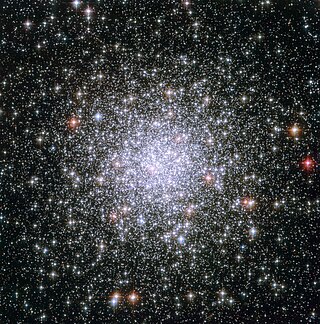Top Qs
Timeline
Chat
Perspective
Messier 69
Globular cluster in the constellation Sagittarius From Wikipedia, the free encyclopedia
Remove ads
Messier 69 or M69, also known NGC 6637, and NGC 6634,[9][10] is a globular cluster in the southern constellation of Sagittarius.[a] It can be found 2.5° to the northeast of the star Epsilon Sagittarii and is dimly visible in 50 mm aperture binoculars. The cluster was discovered by Charles Messier on August 31, 1780, the same night he discovered M70. At the time, he was searching for an object described by Nicolas-Louis de Lacaille in 1751–2 and thought he had rediscovered it, but it is unclear if Lacaille actually described M69.[11]
This cluster is about 28,700[3] light-years away from Earth and 5,200 ly from the Galactic Center,[12] with a spatial radius of 45 light-years.[6] It is a relatively metal-rich globular cluster that is a likely member of the galactic bulge population.[13] It has a mass of 200000 M☉ with a half-mass radius of 11.6 ly,[5] a core radius of 29.2 ly, and a tidal radius of 91.9 ly.[3] Its center has a bright luminosity density of 6,460 L☉·pc−3 (meaning per cubic parsec).[12] It is a close neighbor of its analog M70 – possibly only 1,800 light-years separates the two.[14]
Remove ads
Gallery
- As globular clusters go, M69 is one of the most metal-rich on record.[15]
- Map showing location of M69
See also
References and footnotes
External links
Wikiwand - on
Seamless Wikipedia browsing. On steroids.
Remove ads


![{\displaystyle {\begin{smallmatrix}\left[{\ce {Fe}}/{\ce {H}}\right]\end{smallmatrix}}}](http://wikimedia.org/api/rest_v1/media/math/render/svg/4c0821bd80891e071c08e7c7ee8e022baedf522c)

